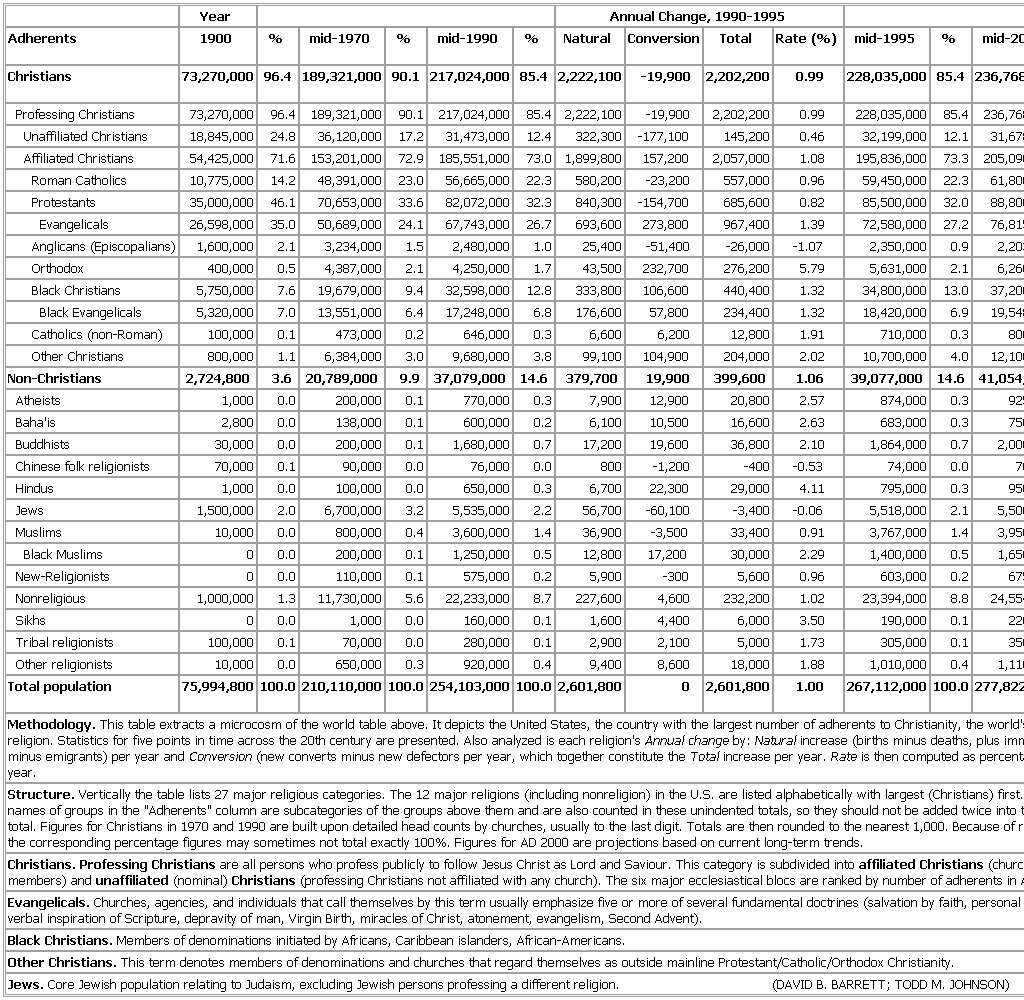Religious Adherents in the United States of America, AD 1900-2000
Table
Religious Adherents in the United States of America, AD 1900-2000
Year Annual Change, 1990-1995
Adherents 1900 % mid-1970 % mid-1990 % Natural Conversion Total Rate (%) mid-1995 % mid-2000 %
Christians 73,270,000 96.4 189,321,000 90.1 217,024,000 85.4 2,222,100 -19,900 2,202,200 0.99 228,035,000 85.4 236,768,000 85.2
Professing Christians 73,270,000 96.4 189,321,000 90.1 217,024,000 85.4 2,222,100 -19,900 2,202,200 0.99 228,035,000 85.4 236,768,000 85.2
Unaffiliated Christians 18,845,000 24.8 36,120,000 17.2 31,473,000 12.4 322,300 -177,100 145,200 0.46 32,199,000 12.1 31,678,000 11.4
Affiliated Christians 54,425,000 71.6 153,201,000 72.9 185,551,000 73.0 1,899,800 157,200 2,057,000 1.08 195,836,000 73.3 205,090,000 73.8
Roman Catholics 10,775,000 14.2 48,391,000 23.0 56,665,000 22.3 580,200 -23,200 557,000 0.96 59,450,000 22.3 61,800,000 22.2
Protestants 35,000,000 46.1 70,653,000 33.6 82,072,000 32.3 840,300 -154,700 685,600 0.82 85,500,000 32.0 88,800,000 32.0
Evangelicals 26,598,000 35.0 50,689,000 24.1 67,743,000 26.7 693,600 273,800 967,400 1.39 72,580,000 27.2 76,815,000 27.6
Anglicans (Episcopalians) 1,600,000 2.1 3,234,000 1.5 2,480,000 1.0 25,400 -51,400 -26,000 -1.07 2,350,000 0.9 2,203,000 0.8
Orthodox 400,000 0.5 4,387,000 2.1 4,250,000 1.7 43,500 232,700 276,200 5.79 5,631,000 2.1 6,260,000 2.3
Black Christians 5,750,000 7.6 19,679,000 9.4 32,598,000 12.8 333,800 106,600 440,400 1.32 34,800,000 13.0 37,200,000 13.4
Black Evangelicals 5,320,000 7.0 13,551,000 6.4 17,248,000 6.8 176,600 57,800 234,400 1.32 18,420,000 6.9 19,548,000 7.0
Catholics (non-Roman) 100,000 0.1 473,000 0.2 646,000 0.3 6,600 6,200 12,800 1.91 710,000 0.3 800,000 0.3
Other Christians 800,000 1.1 6,384,000 3.0 9,680,000 3.8 99,100 104,900 204,000 2.02 10,700,000 4.0 12,100,000 4.4
Non-Christians 2,724,800 3.6 20,789,000 9.9 37,079,000 14.6 379,700 19,900 399,600 1.06 39,077,000 14.6 41,054,000 14.8
Atheists 1,000 0.0 200,000 0.1 770,000 0.3 7,900 12,900 20,800 2.57 874,000 0.3 925,000 0.3
Baha'is 2,800 0.0 138,000 0.1 600,000 0.2 6,100 10,500 16,600 2.63 683,000 0.3 750,000 0.3
Buddhists 30,000 0.0 200,000 0.1 1,680,000 0.7 17,200 19,600 36,800 2.10 1,864,000 0.7 2,000,000 0.7
Chinese folk religionists 70,000 0.1 90,000 0.0 76,000 0.0 800 -1,200 -400 -0.53 74,000 0.0 70,000 0.0
Hindus 1,000 0.0 100,000 0.0 650,000 0.3 6,700 22,300 29,000 4.11 795,000 0.3 950,000 0.3
Jews 1,500,000 2.0 6,700,000 3.2 5,535,000 2.2 56,700 -60,100 -3,400 -0.06 5,518,000 2.1 5,500,000 2.0
Muslims 10,000 0.0 800,000 0.4 3,600,000 1.4 36,900 -3,500 33,400 0.91 3,767,000 1.4 3,950,000 1.4
Black Muslims 0 0.0 200,000 0.1 1,250,000 0.5 12,800 17,200 30,000 2.29 1,400,000 0.5 1,650,000 0.6
New-Religionists 0 0.0 110,000 0.1 575,000 0.2 5,900 -300 5,600 0.96 603,000 0.2 675,000 0.2
Nonreligious 1,000,000 1.3 11,730,000 5.6 22,233,000 8.7 227,600 4,600 232,200 1.02 23,394,000 8.8 24,554,000 8.8
Sikhs 0 0.0 1,000 0.0 160,000 0.1 1,600 4,400 6,000 3.50 190,000 0.1 220,000 0.1
Tribal religionists 100,000 0.1 70,000 0.0 280,000 0.1 2,900 2,100 5,000 1.73 305,000 0.1 350,000 0.1
Other religionists 10,000 0.0 650,000 0.3 920,000 0.4 9,400 8,600 18,000 1.88 1,010,000 0.4 1,110,000 0.4
Total population 75,994,800 100.0 210,110,000 100.0 254,103,000 100.0 2,601,800 0 2,601,800 1.00 267,112,000 100.0 277,822,000 100.0
Methodology. This table extracts a microcosm of the world table above. It depicts the United States, the country with the largest number of adherents to Christianity, the world's largest religion. Statistics for five points in time across the 20th century are presented. Also analyzed is each religion's Annual change by: Natural increase (births minus deaths, plus immigrants minus emigrants) per year and Conversion (new converts minus new defectors per year, which together constitute the Total increase per year. Rate is then computed as percentage per year.
Structure. Vertically the table lists 27 major religious categories. The 12 major religions (including nonreligion) in the U.S. are listed alphabetically with largest (Christians) first. Indented names of groups in the "Adherents" column are subcategories of the groups above them and are also counted in these unindented totals, so they should not be added twice into the column total. Figures for Christians in 1970 and 1990 are built upon detailed head counts by churches, usually to the last digit. Totals are then rounded to the nearest 1,000. Because of rounding, the corresponding percentage figures may sometimes not total exactly 100%. Figures for AD 2000 are projections based on current long-term trends.
Christians. Professing Christians are all persons who profess publicly to follow Jesus Christ as Lord and Saviour. This category is subdivided into affiliated Christians (church members) and unaffiliated (nominal) Christians (professing Christians not affiliated with any church). The six major ecclesiastical blocs are ranked by number of adherents in AD 2000.
Evangelicals. Churches, agencies, and individuals that call themselves by this term usually emphasize five or more of several fundamental doctrines (salvation by faith, personal acceptance, verbal inspiration of Scripture, depravity of man, Virgin Birth, miracles of Christ, atonement, evangelism, Second Advent).
Black Christians. Members of denominations initiated by Africans, Caribbean islanders, African-Americans.
Other Christians. This term denotes members of denominations and churches that regard themselves as outside mainline Protestant/Catholic/Orthodox Christianity.
Jews. Core Jewish population relating to Judaism, excluding Jewish persons professing a different religion. (DAVID B. BARRETT; TODD M. JOHNSON)
See as table:

- Presbyterian Church of England
- Presbyterian Church of Wales
- Presbyterian Church (U.S.A.)
- presbytery
- preschool education
- Prescott
- Prescott, Edward C.
- Prescott, William H(ickling)
- prescription
- presentation
- Presentation of the Virgin Mary
- preservative
- Preserved Smith
- presidency of the United States of America
- president
- Presidente Prudente
- President's Commission on the Status of Women
- Presidents' Day
- Presidents of Mexico from 1917
- Presidents of the United States
- Presley, Elvis
- Prespa, Lake
- Presque Isle
- Pressburger, Emeric
- Pressburg, Treaty of